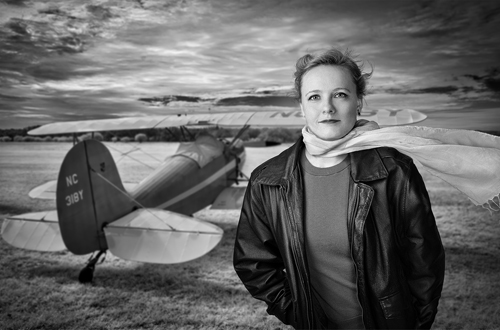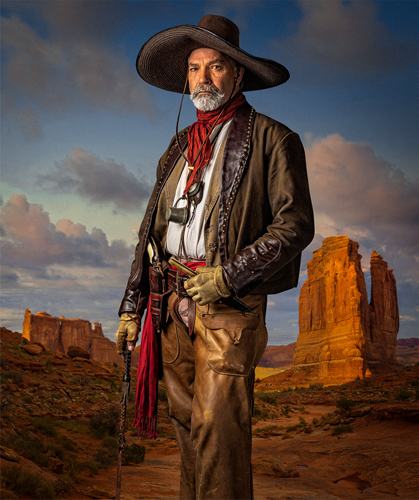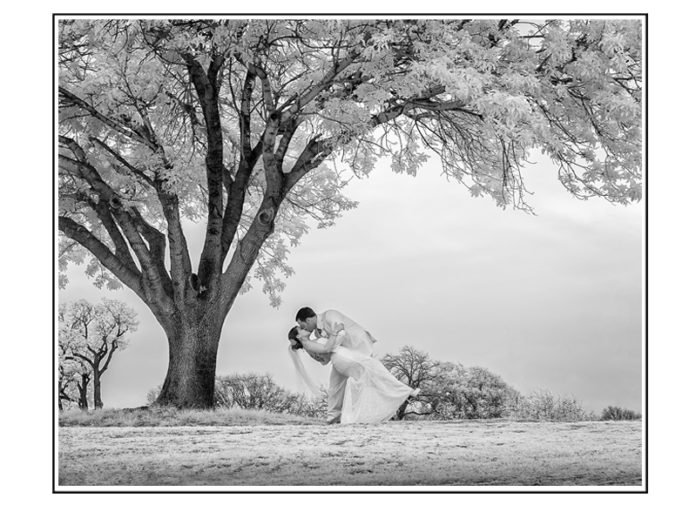Ron Castle’s Journey in the World of Photography
by Bill Hedrick
It was during the dark days of the Vietnam War and Ron Castle was a crew member onboard an EC-121 aircraft, flying missions over the Ho Chi Minh Trail. His job was to monitor seismic sensors and call in air strikes whenever they detected trucks and other traffic. Nothing about it was routine and the risk of being shot down and spending years in a makeshift prison was never far from his mind. His base of operation was Korat Royal Thai Air Force Base in Thailand, a beautiful country not all that far from the war itself.
The hours were long and the danger was real. But all combat flying crews in Thailand were given five days of what they called “crew time off” every month, in addition to the two weeks of R&R that soldiers were given during their tours of Southeast Asia. Two favorite destinations in Thailand were the city of Bangkok or a beach resort called Pattaya Beach. There were other exotic locations as well but you had to pay for your own means of travel. Ron and his buddies often hired their own private taxi to make the most of their time. “I bought a good 35mm SLR (Asahi Pentax) while on a trip to Hong Kong,” he explains. “I had a 24-90mm zoom lens and a 50mm lens that I took everywhere, even on combat flights.”

The colorful, exotic Buddhist temples and monuments, along with the monks, were a never-ending source of subject matter. In his spare time, Ron read everything he could to learn about the technical aspects of photography and practice what he learned. Photography was addicting and soon Ron purchased a nice photo enlarger to make his own black and white prints in a dark room. “I filled up several boxes with Kodachrome slides and black and white negatives while I was there,” says Ron. I’ve managed to salvage some of the negatives and a few years back I spent a great deal of time digitally scanning many of my slides. The quality was pretty poor but at least the memories are there.”
After returning stateside from his tour of duty in Thailand, Ron set up a darkroom in the bathroom of his apartment, duct taping the door cracks to keep the light out. It was a cumbersome process, so he eventually just processed the film and left the printing to the labs. “The more I photographed, the more I thought about the possibility of making it a career, so I used a portion of my GI Bill to enroll in the Famous Photographers correspondence course,” says Ron. Periodically, they would send “students” a packet with information and assignments to photograph and then return prints to them for critiques. “It was a pretty in-depth course,” says Ron, “but overall it fell short of their magazine ads promises.”

Over the course of the next several years, the Air Force was Ron Castle’s career and there was not a lot of time to do much in the way of “serious” photography. But Ron still had his camera ready for occasional trips and would find inspiration now and then for little projects. However, as time went on, the cumbersome nature of film photography along with the expense of processing and printing put a bit of a damper on Ron’s interest in photography. Plus, he was busy. “I was doing a lot of illustrations for my MFA classes and I was busy developing my own water color batik process for my graduate thesis,” he explains.
That process involved doing a pencil drawing on illustration board in a style like paint-by-numbers. Then, using airbrush, Ron would paint with the lightest color and spray it with a fixative to protect that layer’s color from being pulled off. Next, he would paint the areas with liquid frisket (a rubber glue-like substance used by water colorists) where he wanted that color to show through. Working from light to dark, he would cover the illustration with five or six layers of color before finally peeling off all the frisket from the illustration. “Since there was never perfect alignment between layers, the final product was always a unique, spontaneous, batik-like illustration.”

While he was in school completing his MFA degree at the University of Arizona, Ron sold a lot of his Batik work, so he doesn’t have many examples from that time. However, when he left the Air Force in 1977 and moved to Eagle Pass, Texas, Ron found some time to do a series of them which was later used by a San Antonio interior designer in her Parade of Homes entry back in the mid-1980’s. With his foot in the door of the interior design world, Ron would do some commercial design work for his own business and for others. “I even had a brief period when I did a series of pen and ink cartoons,” he recalls. “However, it was never a sustained effort.”
But the real turning point for Ron Castle’s career came when his son, Chris, gave him one of the very earliest Canon 35mm DSLR’s that he’d purchased and wasn’t using. After playing with it and seeing the possibilities of a digital workflow, Ron was completely hooked! “That was in 2009 and, after that, I went all out to learn everything I could about the digital process, as well as off-camera lighting. In 2011, I took a course taught by one of my favorite photographers, Santa Fe based Nevada Wier. I had taken her travel photography class a year earlier when she introduced some of her first infrared images. The following year, I bought a Canon 7D and had it converted to infrared at Life Pixel.”

At that time, the Canon 7D was one of the first Canon cameras with a new touch-screen focus system to help solve one of the biggest problems for infrared-converted cameras… auto-focussing. “When they installed the infrared filter, it pretty much made the auto-focus system useless unless you send in your lens along with your camera so they can calibrate it for you,” says Ron. “Even then, it only worked with that specific lens.”
In addition to studying with Nevada Wier and following her on Facebook, Ron enrolled in Laurie Klein’s Texas School Class back in 2014 and was blown away with her work. Since that time, Ron has continued to work on perfecting his own infrared style. “I didn’t want to rely on some of the over-the-top crazy filters and colors I’ve seen in work done by other photographers,” says Ron. “I prefer a subtle, mostly monochrome look with an emphasis on bringing out detailed contrast.”
During a time period when Ron was photographing weddings, he had always wanted to do a few infrared portraits but usually time didn’t allow for much experimentation. However, one day the stars aligned while he was shooting a wedding on a country club golf course during the early afternoon.
“As it turned out, the lighting conditions were absolutely perfect for infrared… high, thin stratus clouds which acted like a big soft box. In addition, I got lucky with the schedule and had almost an hour and a half before having to photograph the reception. We were already in the perfect location with lots of beautiful trees everywhere and I had my infrared camera with me. But this was the first time I had the courage to pull it out of my bag.”

The experiment paid off big time and one of the images from that day ended up being Ron’s very first print competition merit and later became part of his Diamond case at IPC. “I was encouraged to enter it in IPC when it won as my very first entry in the San Antonio Guild Competition in 2014.” The title of the image is simply “The Kiss.”
Even so, Ron has not entered a stand-alone infrared image in competition since then but has used them as backgrounds for several composites that have merited or loaned, including the background for “Troubled Patriot,” a photograph of his son sitting in a WWI era airplane hangar with a vintage air show at Kingsbury Air Field near Seguin, Texas.
That same image was also a part of Ron’s Diamond case. “My son’s wife’s parents were both very involved in doing re-enactments… Civil War and WWII events. My son’s father-in-law, best-selling author Jim Marrs, was about the same size so he was able to dress up in some of his outfits and model for me in the studio as well,” says Ron.
Ron Also photographed his daughter-in-law in one of those leather WWII German flight jackets and used an infrared image of an antique airplane to composite with one of her portraits which he titled “Aviatrix.” It scored 90 at the Southwest judging but Ron is still scratching his head as to why it was not selected as a Loan Image at IPC. Recently, Ron decided to step up his infrared game and have his 5DSr (50mpxl) camera converted to infrared.
It should be obvious by now that Ron Castle loves photographing historical subjects and then compositing them into backgrounds that he’s photographed elsewhere. In 2015, just after the Texas School of Professional Photography, Ron’s “compadre,” Jim Marrs, invited him to attend a Civil War re-enactment in Jefferson, Texas. Jim had his own Civil War canon which he manned during the event and the canon smoke provided a beautiful background for one of Ron’s other Diamond images, “Yankee Retreat at Jefferson.” While attending that event, Ron made his way to nearby Caddo Lake and made “Lake Caddo Dancer,” shot right off a boat dock. It became one of two Loan Images that put Ron over the top for his Master of Photography degree.
Another favorite event of Ron’s that he’s attended the past few years is the “Deep In The ART of Texas Photoshoot” held near Glenrose, Texas. Doug Prine and his daughter, April, host this event every year in the first week of November at his Buck Creek Ranch. Doug is a painter and the primary purpose of the event is to invite other oil and watercolor painters to photograph models dressed up in a variety of western outfits as subjects for their paintings. “I’m one of the few photographers who attends and I set up a make-shift studio in one of the old west saloons in their small replica West town where I do individual portraits for models.”
He uses a single light… a 30” beauty dish… against a white backdrop so he can extract the images easily. Ron has entered a number of composites done from that venue over the years. One of the images that received a Loan this past year was “One Bad Hombre.” The first time Ron entered the image in TPPA competition, it was a horizontal cropping. But after Cris Duncan’s critique, Ron re-cropped it vertical. “It proved to be a great suggestion,” says Ron.
Devoting so much time and energy to photography can take a toll on you if you aren’t careful and, in 2012, after a twenty-year career as a sales representative for Labatt Food Services in San Antonio, he made up his mind to devote more of his time to his family first. “I’ll keep plugging away at it until I can’t hold a camera anymore,” says Ron. “I still do my real estate and architectural work to subsidize my retirement income but my real passion is doing the composite portraits.” Today, Ron is working on his Master Artist degree and it’s coming along quite well. “I’m getting back to my illustration roots but I’m still working on digital techniques.”
 Most folks are quite familiar with Ron’s commercial photography but he has proven that he is able to produce stunning portrait images of all kinds that are as captivating as they are beautiful. The versatility of his work and the quality of his images is clear evidence that he has come a long way since those early days in Thailand and we’ll all be watching to see what he comes up with next.
Most folks are quite familiar with Ron’s commercial photography but he has proven that he is able to produce stunning portrait images of all kinds that are as captivating as they are beautiful. The versatility of his work and the quality of his images is clear evidence that he has come a long way since those early days in Thailand and we’ll all be watching to see what he comes up with next.
He is he owner of Ron Castle Architectural and Interior Photography located in Del Rio, Texas. You can see his work at www.RonCastlePhotos.com. Or, if you’re down in his neck of the woods, look him up. It’s well worth the drive.











